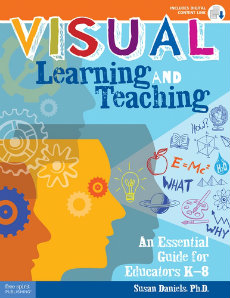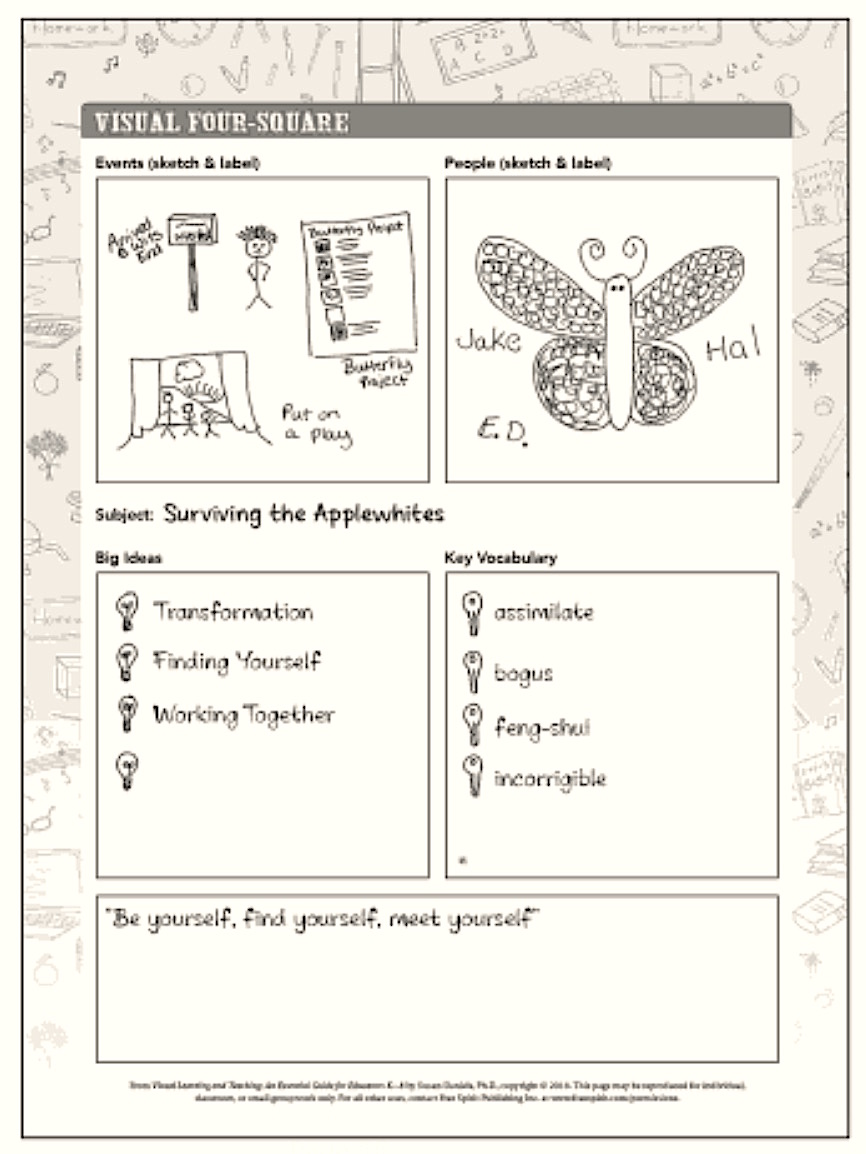The Essentials of Visual Learning and Teaching
Visual Learning and Teaching: An Essential Guide for Educators K-8
By Susan Daniels, Ph.D.
(Free Spirit Publishing, 2018 – Learn more)

Visuals and graphics are all around us. They range from emojis and video games to infographics and road signs. Learning to decode them is an essential skill for everyone, but most especially for visual-spatial learners, which includes most ADHD students.
In addition, author Susan Daniels tells us,
“research continues to document the learning advantages of the picture-superiority effect – the idea that we learn and retain more with images – and, of special importance for our purposes, the drawing effect – the idea that understanding, memory and recall are increased through the integration of semantic, visual and motor experiences.
“As Wammes, Meade and Fernandes noted in the Journal of Experimental Psychology, when we engage in writing and drawing, we are building on dual-coding theory and encoding meaning through three systems: verbal, visual and motor.” (p.60,61)

What’s in Part One
Daniels begins her book by defining and differentiating among the important terms visual literacy, visual language and visual communication. She goes on to give us a brief explanation of auditory-sequential learners and visual-spatial learners. Her chart of their strengths highlights the fact that most of our classrooms are set up to favor the auditory-sequential children, leaving visual-spatial learners at a disadvantage. To remediate this situation, Daniels developed a visual triad model (VTM) of thinking, teaching and learning which includes seeing, imagining and depicting.
To round out Part I of the book, we are given ideas for a visual alphabet along with six essential design elements. There are also oodles of doodle examples and some practical ideas for their use.
Using visual tools to teach
With the basics provided, we go on to chapter 3 which begins Part II: Visual Tools in the Classroom. Here we get to see them put to work. This chapter talks about Visual Notetaking and Graphic Organizers. Starting very simply with flash cards and vocabulary charts, Daniels shows how adding icons or pictures can enhance retention. Graphic organizers are better for taking notes because they offer a structured and visual way to organize information that helps students process and record it.
Many of her ideas use the use of verbal language so students get the best of both worlds. This combo also reaches more children/teens’ various learning needs. The Visual 4 Square example is especially productive. It has two squares for illustrations and the other two are for big ideas and vocabulary. Lots of critical thinking can go on with this one.
Mind Maps and One Pagers are the focus of the next chapter. These assist children in obtaining a deeper understanding of the concepts by using clear structures that require analyzing, synthesizing and evaluating. I was most interested in the one pagers — they allow for exploration on various levels and are adaptable to every subject as well as being able to be utilized as assessments.
The next two chapters give lengthy discussions on icons, diagrams, graphs, maps, timelines, infographics and visual journals. They go into detail about what these images are, how they can be used, and how to create them.
Chapter 7 is all about picture books. Daniels talks about the benefits of using them, viewing, interpreting and analyzing the pictures, and finally and most notably, creating them. Chapter 8’s theme is Visual Learning Portfolios and Reflective Practice. Using portfolios allows us to assess process as well as product, showing growth and improvement in skills by emphasizing what students with individual differences can do.
The last section, Part Three, is Incorporating Visual Tools and Texts into Subject Area Lesson Plans and Curriculum. Chapter 9 gives us tips on creating the curriculum, while 10 and 11 share some actionable ideas for both grades K-3 and 4-8.
After the conclusion you will find all of the printables. This book was a “visual” delight! With all of the examples and inspiration found within the pages, I can’t wait to try some in my classroom.
Joanne Bell is a middle school teacher at St. Joseph Elementary School in Cottleville, Missouri. She currently teaches social studies to sixth and seventh graders, but spent many years in the elementary grades.



































